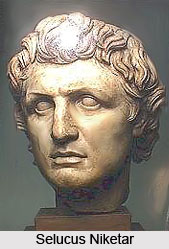 Overpowering the Greeks and the Nandas from northern part of India, Chandragupta Maurya, set out to consolidate his empire. But in his campaign for the strengthening of his empire, he had to contend against the invasion of Selucus, former general of Alexander the Great. Selucus in the meantime had solidified his authority in the Asiatic dominion of his master and marched towards India with the solemn aim to recover the lost territory of his master. But in course of time Chandragupta had already established his supremacy over the whole north India, including the parts occupied by the Macedonian chief Alexander. In these circumstances Selucus crossed the Indus and waged war against Chandragupta Maurya.
Overpowering the Greeks and the Nandas from northern part of India, Chandragupta Maurya, set out to consolidate his empire. But in his campaign for the strengthening of his empire, he had to contend against the invasion of Selucus, former general of Alexander the Great. Selucus in the meantime had solidified his authority in the Asiatic dominion of his master and marched towards India with the solemn aim to recover the lost territory of his master. But in course of time Chandragupta had already established his supremacy over the whole north India, including the parts occupied by the Macedonian chief Alexander. In these circumstances Selucus crossed the Indus and waged war against Chandragupta Maurya.
The information related to the war of Chandragupta with the Greek general Selucus is available from the accounts of the classical historian Appianus. The difficulty arising from the statement of Appianus is that he did not mention actual chronology of the war. According to Bongard Levin, a modern scholar, the sole responsibility of the war between Selucus and Chandragupta lies in the latter`s participation. This is because, Selucus at that time was not in a position to initiate a war against the formidable power of Chandragupta. Rather classical writers opine that Chandragupta taking advantage of Selucus` involvement in a perilous war against Antigonus, another general of Alexander, initiated the struggle against Selucus.
Strangely enough, classical writers remain silent about the details and causes behind the outcome of the war. They however provided an exaggerated detail about the treaty concluded between Chandragupta and Selucus in 305 B.C. However the historians have approached divergent interpretations regarding the nature and the terms of the treaty. According to Dr. R.C. Majumdar, terms of the treaty leave no doubts that Selucus was devastated in his fight against Chandragupta. Going by the treaty, Selucus handed over to Chandragupta the Greek-occupied regions of Aria, Archosia, Paropanisadai, with their respective capital at Herat Kandahar and Kabul. Chandragupta in return, presented Selucus 500 war elephants. Finally the peace treaty between Chandragupta and Selucus was concluded with matrimonial alliance between the two families. In the later years Selucus sent his ambassador Meghasthenes, to the court of Chandragupta as a mark of friendship. In Indika, Meghasthenes has delineated the well-planned government of Chandragupta Maurya with sheer reverence and has also depicted the 500-war horse, which Chandragupta gifted Selucus, playing an important part in his victory against Antigonus. But there lies a controversy among the modern scholars about the marriage alliance between the two families. According to the Indian scholars like R.C .Majumdar, the actual marriage did not take place .It was only an "epigamia" or the agreement of marriage, that Chandragupta had formed with Selucus to endorse the peace treaty. Whatever the controversy is, historians in the recent years have opined that Chandragupta and the Greek chief Selucus were at good terms with each other.



















